|

|
"Imagination is more important than knowledge.
Knowledge is limited ...
Imagination encircles the world."
~Albert Einstein~
|

This is our Unicorn Pixie. Adopt your own from
The Enchanted Hollow
|
The Legend of the Unicorn
The Unicorn is noble;
He keeps him safe and high
Upon a narrow path and steep
Climbing to the sky;
And there no man can take him
He scorns the hunter's darts
And only a virgin's magic power
Shall tame his haughty heart
(A Medieval German Folk Song)
|
|
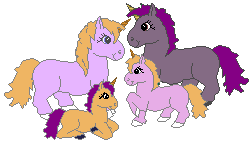
The Legend
The Unicorn, a legendary animal usually depicted as a large horse with a single
horn on its forehead. It has also been described as having the hind legs of an
antelope, the tail of a lion, and the beard of a goat. Represented in the arts of
numerous ancient and medieval Asian and European cultures, the unicorn may
have been created from distorted reports of rhinoceroses. Ctesias, a Greek
physician, about 400 BC wrote a classic description of the unicorn, calling it
an Indian wild ass with a white body, purple head, and a straight "cubit-long" horn
with a white base, black middle, and red tip. He described it as fleet and fierce.
The unicorn is also mentioned in the writings of Aristotle, Pliny, and Aelian. In
medieval Christendom the unicorn was endowed with symbolic qualities, both
religious and secular. Some early translations of the Hebrew scriptures
mentioned the unicorn (modern versions tend to call the same animal a "wild ox"),
and as a biblical beast it acquired ecclesiastical associations. It represented
chastity and purity. Though it would fight savagely when cornered, it could be
tamed by a virgin's touch. Many examples of medieval art including woodcuts,
illuminations, and tapestries depict the unicorn, particularly the hunt for it. In
some Christian interpretations the unicorn is associated with the Virgin Mary;
in others it represents Christ the Redeemer. Unicorns were also popular
emblems in medieval heraldry. During the Middle Ages, and even later, the
unicorn's horn (as it was alleged to be), because of its fabled purity, was a popular
ingredient for medicines and for alchemical reactions. Potentates and pontiffs
obtained reputed unicorn's horn because it was considered strong protection
against poison. The horn was also believed to ward off stomach trouble and
epilepsy. The Unicorn is found throughout world legends. His appearance has
changed over time as writers and artists have taken poetic license and used
their imaginations. The Myth of the Unicorn can be traced back to early pagan
mythology. Oddly enough, this pagan creature was accepted in Medieval Europe,
which was strictly dominated by Christianity, and the Unicorn even became
accepted as a symbol of Christ Himself. The Lady of the Unicorn was a
predominant part of the European Myth. It was said that only the purest of
maidens could tame this beast. When a Unicorn saw a maid sitting in the wood,
he would came forward and docilely lay his head in her lap, as innocent as a
child. This was the Unicorn's one weakness. Some tales tell of a Lady residing in
a cave with the Unicorn. These tales portray the Virgin which loved the Unicorn.
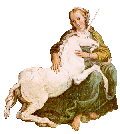
The Modern Unicorn is the result of many different people's imaginations. He
has changed from the delicate, goat-like creature to one of simple equine
beauty. A beast ridden by a Virgin who he can actually trust not to lead him to
the Hunter. He comes in every colour and size, from the purest ivory to the
darkest ebony and every shade of the rainbow in between the two. He can have
the wings of Pegasus and take the name of Alicorn, or he can be given the
leathery wings of a Demon and be a creature yet unnamed. Today's Unicorn is
special to each of his followers, but he still holds the basic principles of nobility,
selflessness, and purity. And he shall always be one of the most beautiful
creatures conceived by the mind of Man. Stories of a magnificent horned steed
filtered into European throughout the Middle Ages. They are believed to have
originated from three sources. First, written accounts from Greek and Roman
sources contributed to the widespread belief in the unicorn. Second, popular
acceptance of the unicorn's existence. Finally, explorers brought back tales of
the beast from other lands. It was in Medieval Europe that the unicorn attained
its greatest fame, and where it began to assume the physical attributes we
associate with it today. The European unicorn took the form of a large, white
steed with a flowing white mane and a tuft of white hair on its chin. In most other
respects it was much like an ordinary horse, except for having white hooves. It
most unusual feature, of course, was the single white spiral horn projecting
forward at an upward angle from its forehead.

|
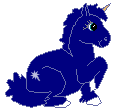
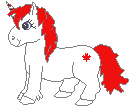 

They followed a forest trail from The Unicorn Friendship Center
|
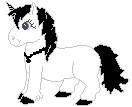
The Noble Unicorn
by Nancy Hathaway
When God created the earth, he made a river which flowed from the garden of
Eden over braided veins of onyx and gold. The river split into 4 branches and
where ever the rivers ran, the land was filled with living things.
There were vines, spiky yucca, dry-dropping quince, mosses, and citrus fruit. And
there were creatures. All were beautiful but only two had names-Adam and Eve,
who didn't know that they had dominance over the others.
Then God told Adam to name the animals. All the creatures gathered around.
They were all equal, and Adam had always been one of them, yet as he began to
name them, he drew himself apart. And the first animal he named was the Unicorn.
When God heard the name Adam had spoken he reached down and touched the
tip of the single horn growing from the animal's forehead. From that moment on,
the Unicorn was elevated above all other beasts.
Adam and Eve rode upon the Unicorn's back throughout the garden and all of
creation was at peace until Adam and Eve became curious about what was
forbidden. Then they tasted of the fruit of knowledge and, ashamed, they clothed
themselves with woven leaves.
When God saw what they had done, he drove them from the garden and barred
the entrance with cherubs waving flaming swords. But God gave the Unicorn
the choice of remaining in paradise or accompanying Adam and Eve into the
world, where there was pestilence, war, pain in childbirth and in death.
The Unicorn looked to the angels with their burning swords and looked to Adam
and Eve-and followed them. Forever after the Unicorn was blessed for its
compassion, for it could have stayed in that place of ideal beauty and delight,
but instead, out of love, it chose the hard way-the human way.

This description taken from "The Last Unicorn" by Peter S. Beagle, puts into
words the grace and beauty of the unicorn.
"She was no longer the careless colour of sea foam but rather the colour of
snow falling on a moonlight night. Her eyes were still clear and unwearied, and
she moved like a shadow on the sea.
She did not look anything like a horned horse as unicorns are often pictured,
being smaller and cloven hoofed, and possessing the oldest, wildest grace that
horses have never had, that deer have only in a shy, thin imitation and goats in
a dancing mockery. Her neck was long and slender, making her head seam
smaller then it was, and the mane that fell almost to the middle of her back was
as soft as dandelion fluff and as fine as cirrus. She had pointed ears and thin
legs, with feathers of white hair at her ankles; and the long horn above her eyes
shone and shivered with its own seashell light even in the deepest midnight."

|


This many visitors have dropped by since March 15, 2000
This page was last updated on January 19, 2007
|
Graphic Credits


Site content Copyright © 2001-2010 AnaStasia
All Rights Reserved
*NOTHING on this page is for download!*
|

|